Toyota Cannot Screw Up the Tacoma
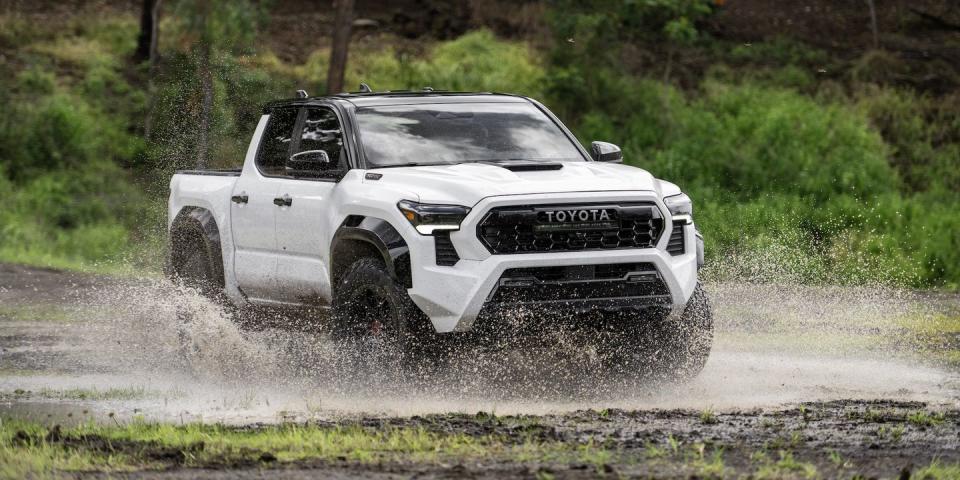
When Toyota debuted the new Tacoma in Hawaii last week, they rolled out all the stops. New Tacomas lined the hillside of a coffee plantation and automotive media were allotted a chunk of time to poke around the pre-production trucks. More importantly, Toyota rolled out a glut of engineers who ushered the project from Genesis to production. I found them to be knowledgeable and educational as ever. But more importantly, they were passionate about Toyota’s new pickup flagship.
As a Tacoma owner myself, that mutual excitement kept the conversation rolling. About 35 minutes after I asked Tacoma Chief Engineer Sheldon Brown “for a quick interview,” I shut my voice recorder off. Then we chatted another five minutes.
What follows is an abridged transcription of that conversation about the 2024 Tacoma, detailing its many new trims, and how you preserve what Brown calls “Tacoma-ness” while improving the truck’s traditional deficiencies: efficiency, power, and comfort.
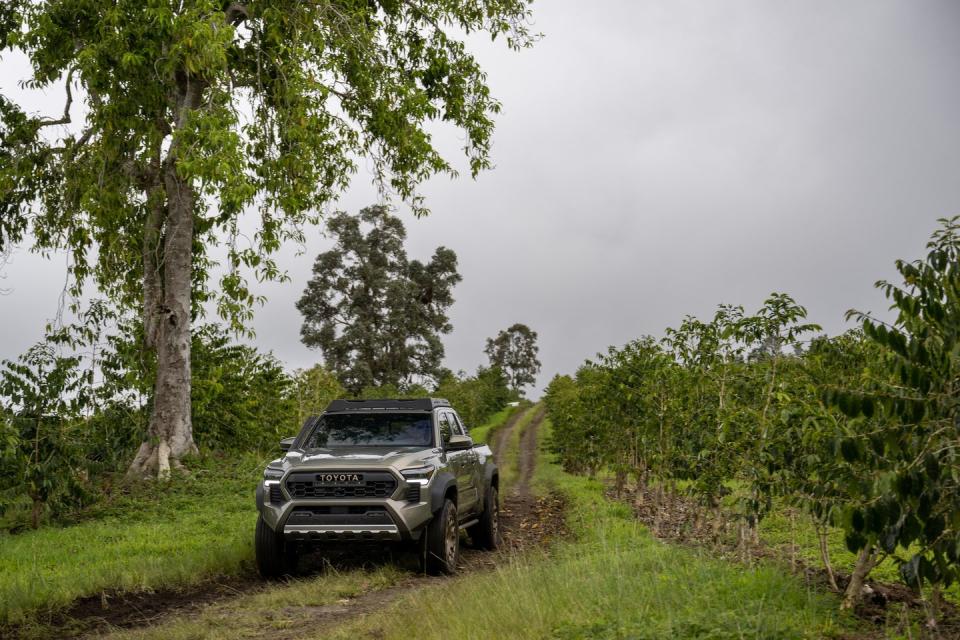
The conversation started as a primer on the project, broad strokes about the gleaming prototypes sat on a volcano in the ocean, but soon the exchange elevated beyond the mountain into birds-eye territory: Why do we love the Tacoma in the first place? How did Brown and his team push the truck’s skillset forward without screwing up the stuff that matters to loyal enthusiasts?
It's a long, conversational dialogue, condensed and edited for clarity. We bounce from subject to subject, but it’s all undiluted Tacoma content here; If you’re the kind of person who, like me, still can’t get enough info about the new Tacoma, please refill your coffee mug and enjoy the perspective of the man who knows the New Tacoma better than any other.
R&T: First, let’s talk a little bit about size and shape. This new Tacoma looks like an origami version of the outgoing truck. But bigger. Where did you choose to increase proportions?
Brown: Like many of the other trucks, with the fundamental underpinnings, we we going to increase the wheelbase. And we also increased the tread. If we look at an SR-5 in the outgoing generation, the tread on the new truck is almost six inches wider. So we added three inches to the base model’s wheelbase and we go another three when we get to the halos here [Ed’s note: Brown refers to the high-end trims like the TRD Pro and Trailhunter as the line’s “halo” products]. This is 3685mm at the wheelbase here, [Brown gestures at the Trailhunter], cuz it is our long wheelbase. So this Trailhunter is our double cab with a six-foot deck. It’s actually the longest truck we have. This is available in a five-foot deck configuration and 3350-mm wheelbase. Obviously when we did that, we needed big high wheel arches, and big, large over-fenders.
We really wanted that wider stance because especially on this truck, people are putting a bunch of gear on it. So in general, the center of gravity on that truck gets higher and higher. So it's really important that you have good stability and that really wide footprint helps.
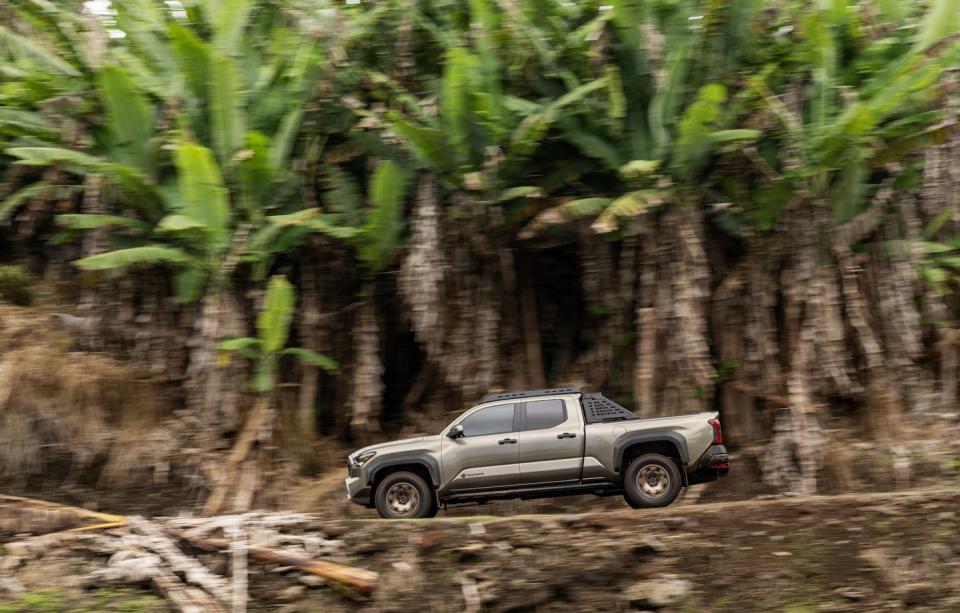
R&T: Just visually, on a truck like the TRD Pro or Trailhunter, it looks like you’ve baked in all the usual-suspect aftermarket parts. It’s like you can just buy this truck and never open an aftermarket catalog.
Brown: Perfect point. We're doing a lot more, I'll say ‘strategic marketing’ or co-branding with legitimate partners with aftermarket off-road experience. We're taking their experience together with what we do well and trying to integrate that experience into the product. Our goal is that you can't tell where OE stops and where the accessories begin.
Everything that you see on the Trail Hunter, with the exception of that roof rack, is standard; It comes this way right from the factory. So that means as we look underneath there, you're gonna see we have a front bash plate. We've got a skid plate that protects the center body. Full fuel tank protection as well as a rear diff cover on here.
And then along the frame rail, those are legit rock rails. Those are basically fastened directly to the frame, capable of taking 50% of GVW, tested by us internally.
So you keep all the functionality, and that's the area where we really think that we can provide value to the customers. And to go to the aftermarket and make sure you still get all that functionality? It’s really hard for them to provide. It's really hard for us to do, so we know it's gotta be more difficult for them.
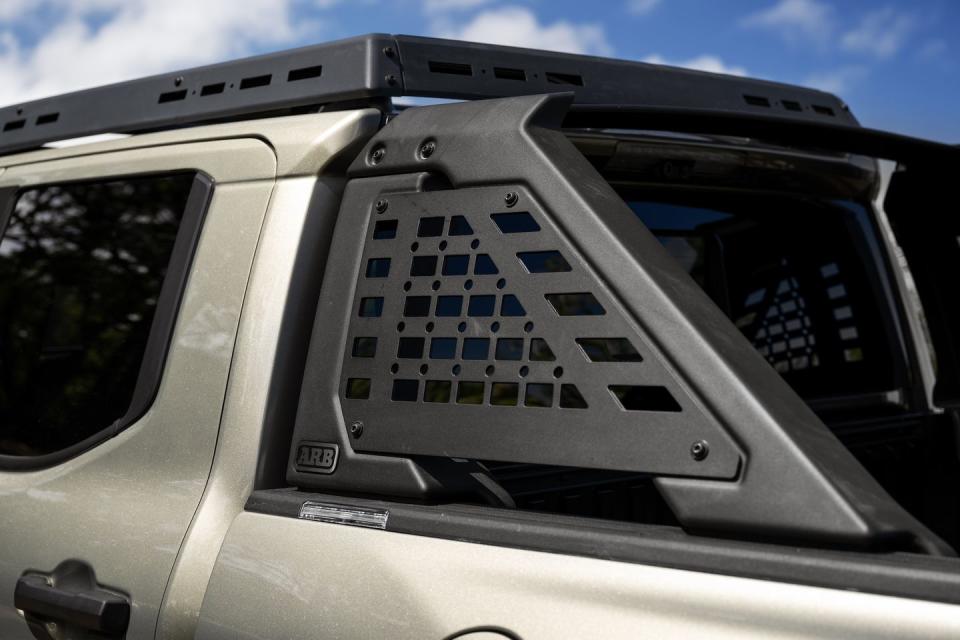
R&T: How do you pick and choose where to apply that aftermarket-ification? These trucks, year over year, generation over generation, are taking bounds in overall capability. But there's a huge cost for you guys to develop and chase relatively niche aftermarket solutions.
Is it customers asking for a factory option, or Toyota looking at how everybody throws new shocks on their Tacoma, and thinking ‘we’d like a piece of that action’?
Brown: We try to look at areas where we can provide value to the customer, right. Where there's intricate integration. When you start to play with like suspension geometry, that becomes very complicated. And we understand how that tinkering impacts all of the truck’s systems, including our electronic traction control systems and VSC and other things.
So these are areas where we think that we can be probably more competitive and provide value. The same thing goes where we can integrate accessories into the truck. If we can’t already provide access for rock rails, that's gonna be something that you're gonna otherwise have to modify, or drill holes in your frame, or do something else. So yeah, if there is a chance where we can prevent you from having to replace and throw away, or we can provide a convenience or a benefit, that's where we want to be out front, and that's where we think we bring the most value.
On the top of that, every single vehicle has bolt points for a roof rack. You could use our roof rack. But if you don't want to, it's okay. We want to be the platform that you can use and we wanna make it easier to use.
It’s the same with the concept of the auxiliary switches. It's much easier for us to put that in the fuse box from the factory. Do what you wanna do with that. If you wanna put in ditch lights, if you wanna put rear lighting, you can decide that yourself. Yeah. We're just gonna make it easier for you.
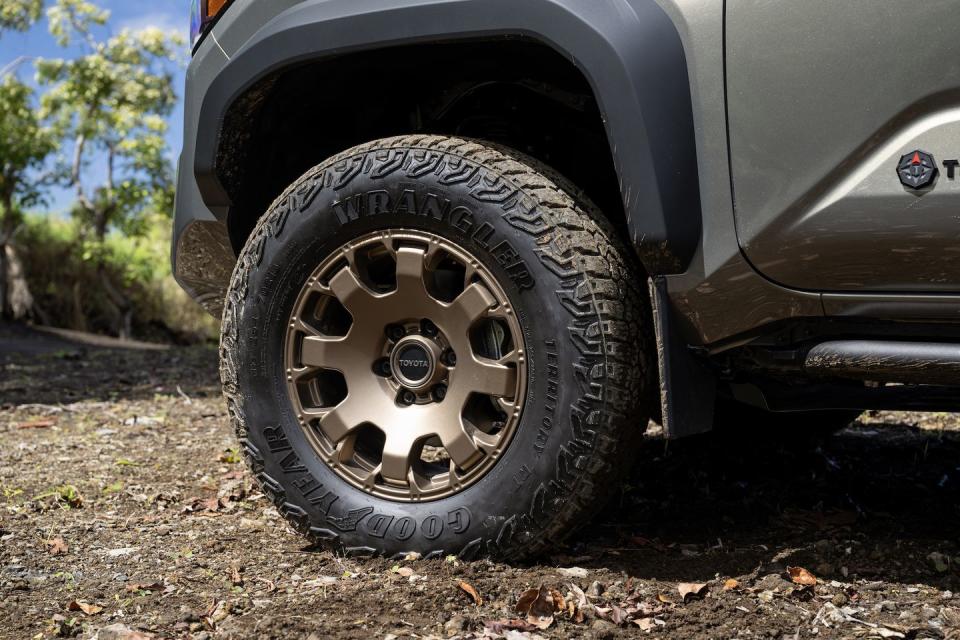
R&T: So will there be a factory parts sales component then? If an SR-5 buyer wants the wants all TRD Pro goodies, are they available?
Brown: In a lot of different cases, yes. For example, on the rocker or on the frame, we’re usually gonna have to weld up unused holes. But we might actually drive a bolt in there to keep all the water out and everything. So if you wanna pick up those rock rails and bolt them under your truck, not a problem.
Same thing goes for the deck racks. This is our sport rack that comes standard. You can actually unbolt that top piece and use the front leg, and just buy the rear two and that becomes a full deck rack. So it's convertible. If you want that on your SR-5, no problem. Even the snorkel, fundamentally, you could actually buy a pre-punched replacement fender that we offer from the dealer. And then of course, replace the air boxes. You've got the plumbing that's right there and you're good to go.
R&T: Let’s talk about powertrains. Obviously this is the core Tacoma evolution. How did you go about thinking of and designing for the future? When did you know hybridization was eventual?
Brown: Obviously with our powertrain division as well as our vehicle lineup, we're always gonna be looking five, 10, 15 years down the road, right? We're trying to imagine what external influences like regulatory environments are gonna be like.
But we're also trying to think about what the customer is gonna want and how we can best provide that. Toyota has for a long time been committed to electrification across this entire lineup. And obviously trucks are some of our last vehicles to be able to come online. So electrification, at least in the hybrid area, was a no-brainer.
And then when you start to look at smaller-displacement engines, how do we make sure that we get that torque and really blow our customers' minds?
That's where we can really take the best of both worlds, right? But this is really focused on power, better emissions, better torque, better fuel economy.
It's truly a win-win for the customer.
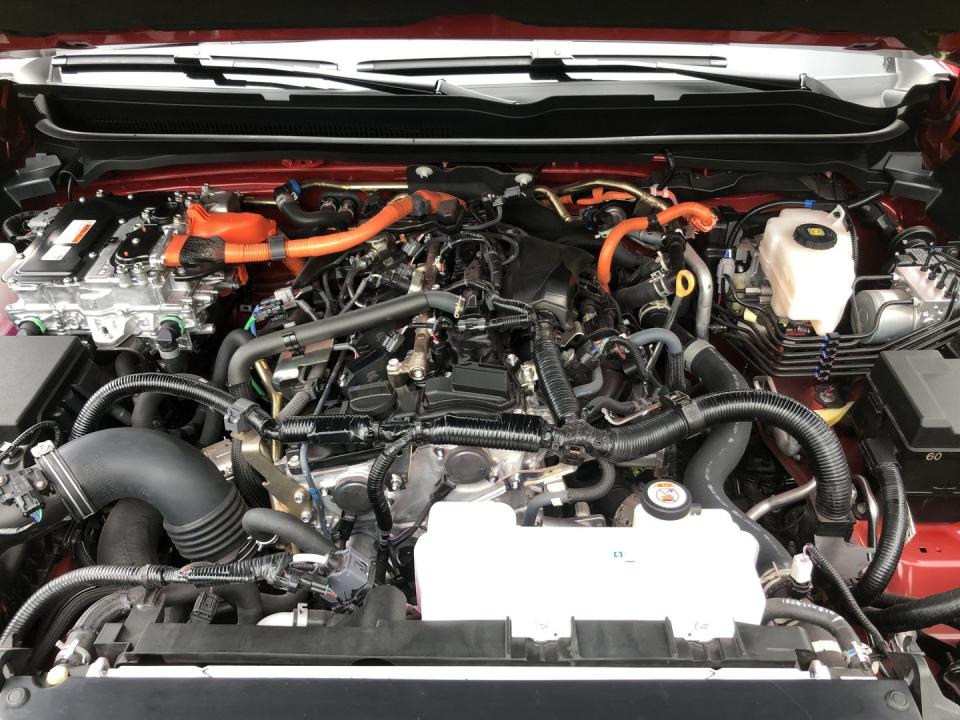
R&T: Is a hybrid four-cylinder a tough sell for Tacoma buyers? Obviously there were the four-cylinder Tacomas, but they were not the volume model; There's this idea among the Tacoma faithful that a big, under-stressed V-6 was the engine to take you all the way, that you proudly suffer the poor mpg and power on the altar of reliability.
And yet Toyota has had hybrid vehicles around forever. So there's the Toyota buyer who’s accustomed to hybrids, but then also the Tacoma buyer. That’s a Venn diagram that doesn't overlap completely. Do you think it's just a straightforward sell because everything is so improved on paper? Or do you think there will be reluctance with four-cylinder hybrid adoption?
Brown: Yeah. It's a good question. It's a fair question. I think the bigger stretch was probably in the full-size segment, where people were really accustomed to large displacement. In large-displacement engines, that meant power and torque. We're already a little bit ahead of the game cause we've already seen some of the smaller displacement engines in the compact segment.
But what I think is gonna become more and more commonplace are vehicles with lower displacement and higher boost. Motors across all different automakers. So this is gonna be a little bit more mainstream. And if we really think about it, this is not like our first rodeo. Actually, you can go back a decade, decade-and-a-half and we've had turbos around.
They weren't mainstream in North America as much as, you know, we have had them globally. And so the technology development we've done over all of our powertrains, especially our hybrid powertrain systems, all of that know-how gets dumped into here. We're not starting at the base here.
And the other question becomes turbo and turbo durability, that's the other one that we hear a lot of people talking about. And again, we've got a pretty rich history in using turbos across various different powertrain configurations. But I, you know, I always tell folks, look, QDR: it's quality, dependability, reliability.
QDR is our lifeblood. It's what we stake our reputation on. So all of the components in this engine go through all of the same sort of torture testing, the same load testing that all of our traditional power trains have gone through. When we went to the turbos, we even decided we're gonna take it a step further. On the truck series, we actually take our, our twin-scroll turbos and we actually we require those to meet our commercial standards.
That's 33% more life cycle and duty. We know because truck users are gonna be towing and they're gonna be hauling and you might be boosting a little bit more. So in those particular cases, we wanna make sure to meet those standards. So these things have been put through the ringer on the dyno, off the dyno, and in the real world. So by the time it gets to our customer, what I think they're gonna find out is they're gonna get more power, more torque, better fuel economy. And, you know, the one that we don't always think about, but dramatically improved emissions.
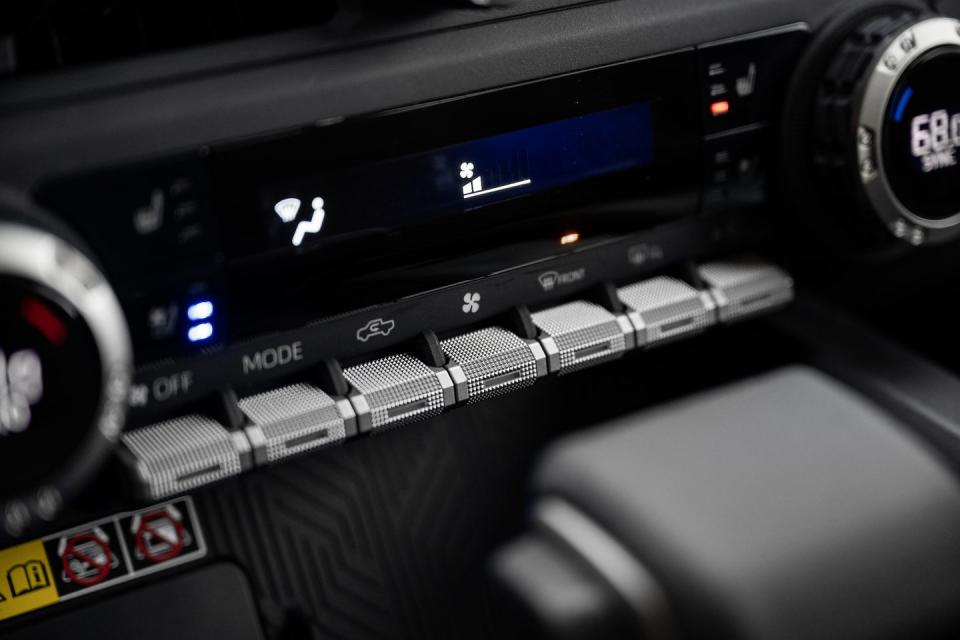
R&T: How do you apply that thinking to other areas of the truck and keep customers on board? Modern regulation requires more efficiency from the vehicle, that’s one thing. But equally, truck buyers yearn for a certain amount of simplicity and honesty. In an interior, you have to provide a screen with Carplay now, but keep it simple enough that old-school Tacoma buyers don’t get flustered.
Brown: We’re pretty strategic and about how we wanna lay that out. I think we're all sort of moving into this world of digital and electronic comfort features. And so we want to bring things like that honestly just didn't exist before. And the reason they may not have been in the Tacoma is because just nobody had reliable, repeatable cameras that you could use. I think just about everybody nowadays would tell you like, ‘Hey, backing up to a trailer with a camera, it's a whole lot better if you're on your own.’ So those are areas where I think we can cherry pick and we can say ‘this makes a lot of sense.’
Some of these other electronic features make a lot of sense. I love having a huge 14-inch screen. I can take a look at what's going on in the front of my truck in a multi-terrain view. Right. I can see what's happening on the side so I'm not scrubbing and rubbing.
I think customers are gonna like that, but then there's some very fundamental things like, you know, I don't want you to have to go hunting through the screen to change the temperature. So for those areas like HVAC control where we can use a simple button or a dial that I can just flip or flip a roll or like our, our power train controller where everything is right here, four little buttons.
I never have to leave my eyes off the road. I can just feel for the buttons. Press it. Flip the dial. It's all very intuitive. So I think we were a little bit strategic, right? We didn't try to say, ‘okay, we're getting rid of all the buttons, all the physical controls and everything's in the screen.’ I don't know that there's a better way to change your temperature than just flick the dial one way, flick the dial the other way.
R&T: I noticed the giant volume knob right in the center of the dash. It's undefeated, right? The volume knob is undefeated.
Brown: We haven't done much in making wheels any rounder. You know, cuz that's a pretty damn good design right there. I think that's kind of like the ‘keep it simple’ part, where we can bring value. When we can bring convenience, when we can make the customer's life easier, let's do it. But we don't have to outthink ourselves.

R&T: So as these are rolling out is, has the entirety of Tacoma production moved to Mexico? It was sort of tapering off with the third-gen truck in some trims still built in Texas.
Brown: Yeah. So with the launch of the 2022 Tundra, basically that was the full transition where basically we brought that vehicle online [for production in Texas]. Obviously the forecasted sales volumes have increased for that truck. And we brought, you know, Sequoia in line there. Yeah. So unfortunately there was no more room for us in Texas. We had to go we had to go find a new place to build Tacomas.
R&T: I was mostly curious because demand remains high for Tacomas; it’s still outstripping supply. Will you be able to catch up with this truck? Will customers who want a Tacoma be able to get one easily? Or is all that pent-up demand from the chip shortage still in effect?
Brown: There's a little bit of both. We have two manufacturing facilities in Mexico now. We have our, our one facility, then the one that we have on the west coast in Baja California, so we probably have the volume now. I should say we have the capacity now. But you know, you pick a global pandemic as it has rotated from Continent to continent, area to area. We, we've got a global supply base, right? A global supply chain. And we still are seeing a lot of disruptions there. We are seeing things, you know, whether it be raw materials, labor shortages, logistics challenges. We're kind of coming out of the chip crisis but we're not really out of the woods yet. I think our sales and marketing can tell you better, but, you know, we're down to a single day or maybe a double-digit day supply of trucks and we're pumping 'em out as fast as we can get parts to put on it.
R&T: Sure. Okay. And when can we expect pricing information?
Brown: It won't be released till later this probably end of this year.
R&T: Just broadly, do you have an inclination on price? Will there be sort of a meaningful step up in price across the trim levels? Is there anything consumers can expect?
Brown: Unfortunately, I don't. It'll be important that we look at spec to spec to make sure that you can do that comparison. But what I'll say is that we are very cognizant of the range that we need to cover. In the compact segment and maybe more so than any other segment, that entry price point, and making sure that we have that affordable truck for someone who's really looking for a value opportunity.
They love a basic truck and it meets all their needs. It doesn't have to have all the bells and whistles. So that was really the genesis in why we came up with extra cab, to make sure we could maximize efficiencies. We can take that value, pass that value along to our customer with a competitive entry level product.
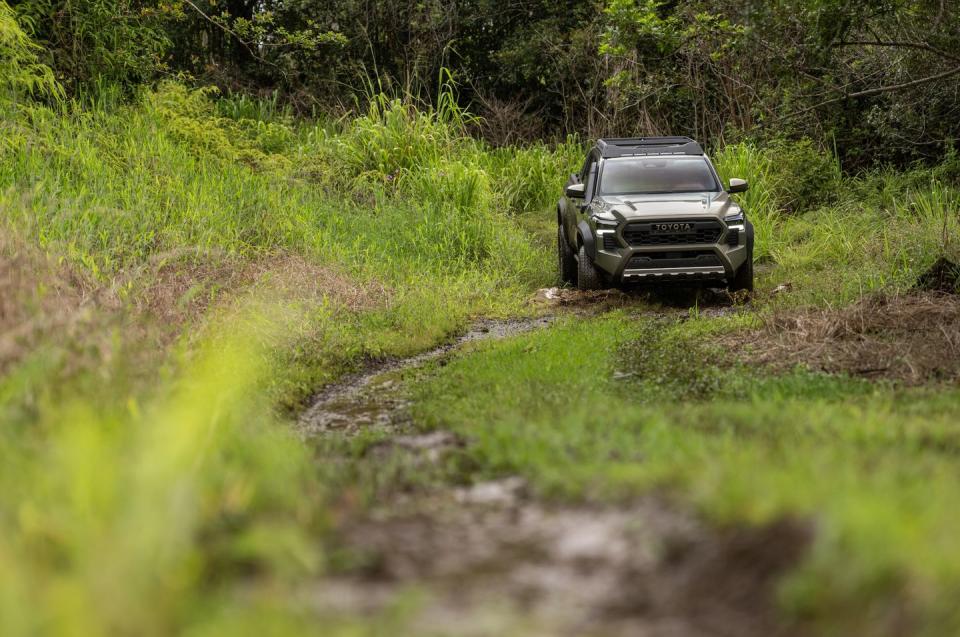
R&T: Yeah. That’s an interesting idea, that stratification. Most of the truck market isn’t heading that direction. Options are much more limited for powertrains and cab configurations. How do you justify something like a Tacoma Limited, which only 5% of Tacoma buyers choose? How do you justify a truck with a manual transmission in 2023?
Brown: Let's just think about the market, right? I think the market is best described in the shape of a bell curve. You've got some folks that want to be at the very low end, where they want the most efficiency and lowest cost of operation, the lowest entry price. And so they're willing to say, ‘Hey, four wheels and a couple of pedals, let's go.’
Then you go to the opposite side of the curve, to the person that says, ‘I want the amenities of a full-size truck. I want the creature comforts. I'm not looking for something that's gonna go off-road, but I want the right-sized truck.’
R&T: So you see opportunity on each end of the bell curve, no matter how niche?
Brown: Of course. The extra cab was on the far side of the bell curve too. It seems that our competitors have decided to focus here, in the center, by whittling down options like an extra cab or a manual transmission. But I don't necessarily think they have simplified their cost structure. Cause they have packages that you put on, and lifts.
So they've basically simplified their offerings, but really what they've done is they sort of narrowed in these areas where people are searching for an extended deck. Where people are looking for, you know, something like an entry level truck. They're kind of forcing you to go immediately into like a double cab, right?
So gone are the days where you could have a lower cost entry. All they've really done is try to live in the middle.. We think that we index very well in the middle. We wanted to be competitive to make sure that we are still hyper-competitive in that area. But we felt that we'd like to also provide a little bit more on the entry side as well as on the premium.
R&T: From a 30,000-foot perspective, how do you balance complexity and convenience versus the truck’s basic Tacoma-ness? Are all the trucks getting fancy power tailgates now?
Brown: You know, today's selection of trucks is an interesting sampling, because we have shown a few of the premium ones. Most of your TRD grades are not gonna have a power tailgate. It would be an option for you. Obviously this tailgate is kind of a new thing. It's kind of fun. So we wanted to make sure we highlighted it.
But we made the tailgate aluminum. Took out about 30% of the mass. So we've tried to use our materials to spend in those areas that would have customer value. I've taken mass out of the deck side by making it aluminum, out of the tailgate.
R&T: You’re talking about materials complexity that, for the customer, provides extra capability in a non-obvious way?
Brown: Mmhmm. The resin molded deck is actually 20% glass-filled, so it's actually got better impact performance. And it's basically 14% lighter. So what do I do with that? I kind of put that back into the truck. So we can increase our payload capacity, for example. So these are areas that the customer benefits. We made the hood aluminum, took 34% of the mass out of that, made it easier to lift open and close. So it's good value for the customer. And the customer gets something out of it, right? Yeah. We can give something back. The SR five is still a great truck, but it's not gonna necessarily have all the bells and whistles.
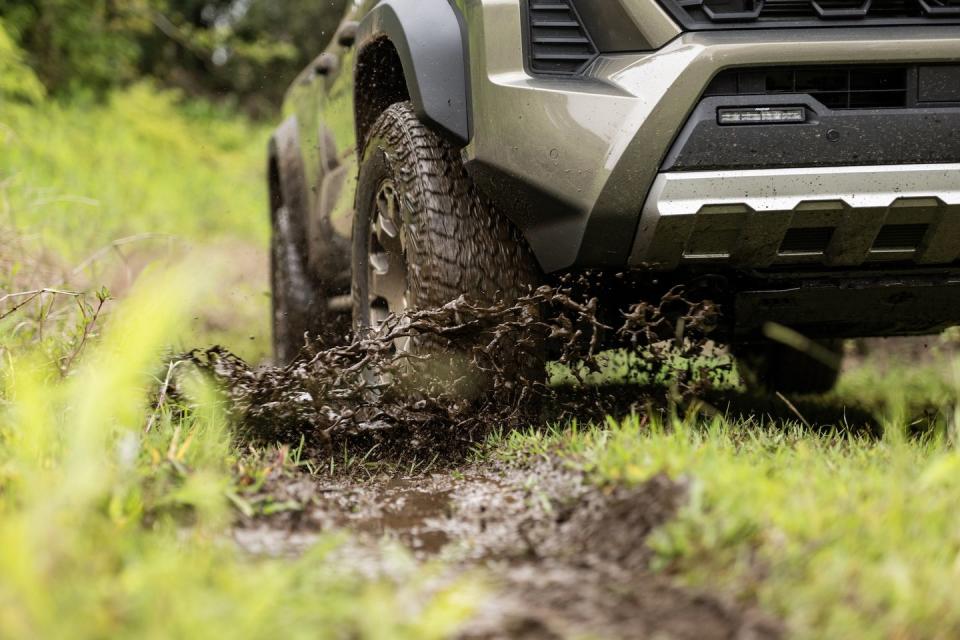
R&T: So customers aren’t neccessarily married to the complexity they don’t want. You’re saying they have choice, basically?
Brown: So for example, we still have a manual HVAC that we put in our entry trucks. You get a single-zone in that sort of core mid-range truck. And then when you bump up the premium, we give you the dual-zone for example. Again, we're trying. You don't always have to get a 14-inch display. We do offer an eight-inch display.
R&T: Complex or not, I don’t imagine you’ll have any Tacoma owners complaining about the new stereo. It sounds much better than the one on my third-gen.
Brown: That was something I told the guys, ‘If we're gonna do this, we're gonna do it right.’ Yeah. So really especially with that subwoofer, yeah. We can really get some thump.
R&T: Were there any customer demands you really had to fight to integrate? Or is it just a case that when you're starting a clean-sheet design of something this high-profile, that provides the internal leverage to meet demands?
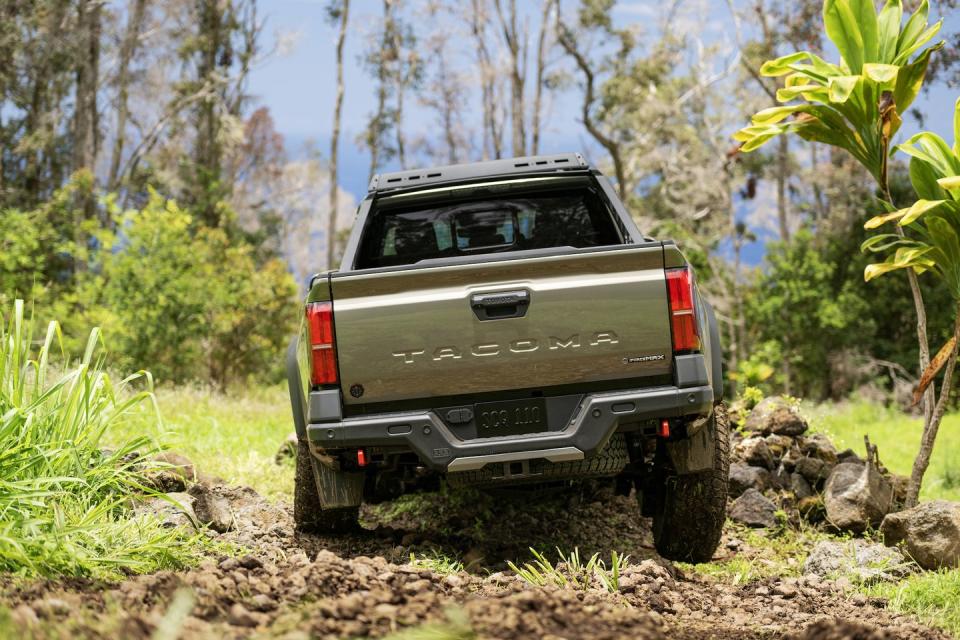
Brown: Everything's a challenge. First and foremost—and this came loud and clear—we gotta be able to park this truck in the garage. It would've been much easier for us if we had just extended that overhang a little bit more. We’d have a little less in the approach angle. But it’s no big deal.
Length was an absolute, absolute deal breaker. So we were gonna hold that 5416-mm license-plate-to-rear-bumper measurement.
The second area, of course is the door to door. You'll notice even though we got a little bit wider in our wheelbase, we kept the door to door identical. That way you can get the door open and sneak out.
So that was another ‘Thou shalt not.’ The manual transmission is another example, right? Folks who love the manual transmission are like, ‘don't kill the manual’. There was some political capital spent there to make sure that we got that across the line.
Obviously improving fuel economy and drivability, we heard that loud and clear our customers wanted a little bit better performance. I can't wait to get you in the seat of this truck. It's well-mannered.
So you think about vehicle dynamics, you think about lateral rigidity and handling. You think about quietness, you think about linear braking, and you think about linear control on the steering wheel. All of that goes into a fantastic driving experience. Mess any of those up and you diminish that experience.
And that has been our hyper focus, don't chase big numbers. We're not worried about catalog shopping. I don't want to tow 10,000 pounds in this truck and never do. It's not built for that. And so we don't chase a goal that isn't something our customers value. We know that, once you cross about 5,000 pounds, you're gonna meet 90% of of our customers towing these.
We bring it up to 6,000 or 6,400 on our most premium or our most-capable towing vehicles. Chasing further than that is just diminishing returns. And you're probably gonna give something else up to do that. Right?
You're gonna give up ride comfort or something. So it was important for us to make sure that we had, what are our core attributes? What do those customers love? And then really dial it and focus on that. So we wanted to make sure that it was nimble.
We had to tuck everything up high so that we could maintain the breakover angle. And that's tough to do. And then the same thing: as the vehicle gets a little bit wider, we wanted to make sure that our steering radius was maintained. So we lost maybe one-tenth of a meter or so, but fundamentally we're able to keep it the same. But those are important pieces because that's what people maybe don't realize they love so much until it's gone.
So one of the, you know, the tenets was ‘first do no harm.’ And then, then take it to that whole next level.
You Might Also Like

 Yahoo Autos
Yahoo Autos 